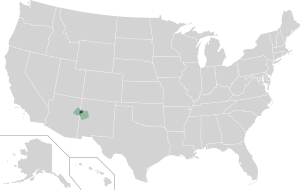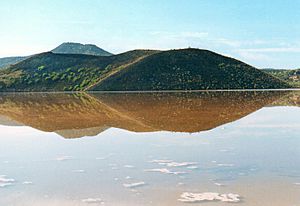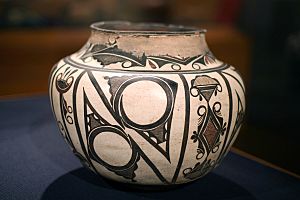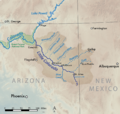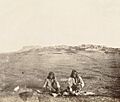Zuni people facts for kids
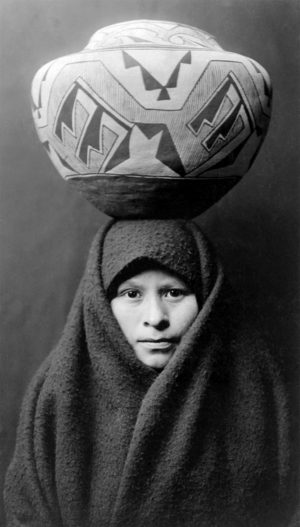
Zuni girl with jar, 1903
|
|
| Total population | |
|---|---|
| 19,228 enrolled members (2015) | |
| Regions with significant populations | |
| United States (New Mexico) | |
| Languages | |
| Zuni, English, Spanish | |
| Related ethnic groups | |
| Pueblo people |
The Zuni (Zuni: A:shiwi) are a group of Native American people. They are part of the Pueblo people and have lived in the Zuni River valley for a very long time.
Today, most Zuni people live in the Pueblo of Zuni. This is a special area in western New Mexico, United States. The Zuni Pueblo is about 55 kilometers (34 miles) south of Gallup, New Mexico. The Zuni traditionally lived in multi-level homes made of adobe, a type of mud brick. They call their homeland Halona Idiwan’a, which means "Middle Place."
Contents
Zuni History: A Journey Through Time
Archaeologists believe the Zuni have been farming in their current home for 3,000 to 4,000 years. The first Zuni ancestors started farming maize (corn) using irrigation around 1000 BCE.
Early Zuni Villages
Before the Zuni, other ancient cultures like the Mogollon and Ancestral Pueblo peoples lived in the deserts of New Mexico and nearby states. Around 700 A.D., early Zuni settlements like White Mound had pit houses and storage rooms. These villages often included kivas, which are special rooms used for ceremonies.
By the 12th century, Zuni settlements grew larger. Some villages were built on top of high, flat areas called mesas, like Atsinna. In the 14th century, the Zuni lived in many pueblos, some with hundreds of rooms. They moved to the western part of their land and built six new villages. One of these, Hawikuh, was mistakenly thought by Spanish explorers to be one of the legendary Seven Cities of Cibola.
First Contact with Europeans
In 1539, a Moorish slave named Estevanico was the first non-native person to reach the Zuni. The Zuni reportedly killed him. This was the first time the Spanish met any Pueblo people.
In 1540, Francisco Vásquez de Coronado led a large Spanish expedition to the Zuni lands. They fought with Zuni warriors near Hawikuh and captured the village. Spanish priests and soldiers stayed for a few years. Other Spanish explorers visited in the late 1500s.
In 1629, the Spanish built a mission church at Hawikuh. The Zuni later destroyed the missions and moved to a strong defensive position on top of Dowa Yalanne, a steep mesa. They stayed there for three years. The Spanish built another mission in 1643.
Life After the Pueblo Revolt
Before the Pueblo Revolt of 1680, the Zuni lived in six villages. After the revolt, they again took refuge on Dowa Yalanne until 1692. Dowa Yalanne means "corn mountain."
After peace was made with the Spanish, the Zuni moved to their current location. By the end of the 17th century, only Halona, one of the original six villages, was still lived in. However, smaller villages like Nutria and Ojo Caliente grew up around it.
By the late 1700s, the Spanish had mostly stopped trying to control the Zuni. In 1821, the Franciscan missionaries left.
Zuni and the United States
In 1848, the U.S. Army signed a treaty with Zuni and Navajo leaders. This treaty promised to protect the Zuni's property and religion. In the 1850s, an observer noted how hard the Zuni worked in their fields, growing wheat, corn, and melons.
The Zuni Reservation was officially created by the U.S. government in 1877. It was made larger in 1883.
Frank Hamilton Cushing, an anthropologist from the Smithsonian Institution, lived with the Zuni from 1879 to 1884. He studied their way of life. However, some Zuni people later felt he had shared sacred traditions without permission.
In the early 2000s, the Zuni opposed a plan to build a coal mine near the Zuni Salt Lake. This lake is a very sacred place for the Zuni. The mine would have taken water from under the lake. After several lawsuits, the plan was stopped in 2003.
Zuni Culture and Traditions
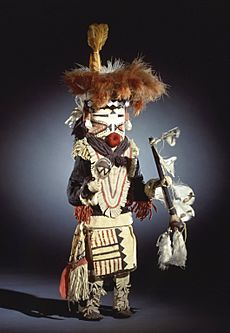
The Zuni people traditionally speak the Zuni language. This language is unique and not known to be related to any other Native American language. Experts believe the Zuni have kept their language pure for 6,000 to 7,000 years!
The Zuni still practice their traditional religion. They have regular ceremonies and dances.
Daily Life and Economy
The Zuni were, and still are, a traditional people. They used irrigated agriculture to grow crops. Over time, they also started raising sheep and cattle. Their success in farming in the desert comes from carefully managing their resources and working together as a community.
Many Zuni people today earn money by selling traditional arts and crafts. Some Zuni still live in the old-style pueblos, while others live in modern homes. Even though their location is a bit isolated, they welcome respectful visitors.
The Zuni Tribal Fair and rodeo happens every August. The Zuni also take part in the Gallup Inter-Tribal Ceremonial. The A:shiwi A:wan Museum and Heritage Center is a museum that shows Zuni history, culture, and art.
Zuni Pottery: Art from Clay
Traditionally, Zuni women made pottery to store food and water. They often used symbols from their family groups (clans) in their designs. The clay for pottery comes from local areas. Before taking the clay, the women give thanks to the Earth Mother (Awidelin Tsitda).
The clay is prepared, shaped into a pot, and smoothed. A thin layer of fine clay, called slip, is added for a smooth surface and color. After drying, the pot is polished with a stone. Then, it's painted with natural dyes using a traditional yucca brush. The shape and painted pictures depend on what the pottery will be used for.
To bake the pottery, the Zuni used animal dung in traditional kilns. Today, some Zuni potters use electric kilns. During the baking process, it was important to be quiet or speak softly. This was to keep the "voice" of the clay and the purpose of the pot strong.
Selling pottery and other traditional arts is a major way many Zuni people earn money today. Common designs on Zuni pots include spirals with triangles, deer, frogs, and dragonflies. These symbols are often linked to rain and water.
Carving and Jewelry: Silver and Stone
The Zuni are also known for making fetishes (carved animal figures) and necklaces. These were used for rituals and trade, and now are sold to collectors.
Zuni jewelers are famous for their beautiful work with lapidary (cutting and polishing stones). They set hand-cut turquoise and other stones in silver. Many Zuni have become expert stone-cutters. They use special methods like mosaic and channel inlay to create detailed designs.
Two unique Zuni jewelry styles are needlepoint and petit point. In needlepoint, small, oval-shaped stones with pointed ends are set close together in silver. This is often done with turquoise, coral, or other stones to make necklaces, bracelets, earrings, and rings. Petit point is similar, but one end of each stone is pointed, and the other is rounded.
Zuni Religion and Beliefs
Religion is very important to Zuni life. Their traditional beliefs focus on three powerful deities: Earth Mother, Sun Father, and Moonlight-Giving Mother. Their religion is based on katsina spirits. Ceremonies happen during the winter solstice, summer, harvest, and again in winter.
The religious leaders include three priests. The Pekwin (the "above" priest) decides the religious calendar. Each boy is welcomed into one of the religious societies linked to the six kivas.
Shalako Ceremony
The Shalako is a series of special ceremonial dances. They happen all night long around the winter solstice. These ceremonies are usually private and only for Zuni people, unless a tribal member invites an outsider.
The ceremony also blesses new houses built during the year. This blessing involves singing that goes along with six dancers. These dancers wear very tall Shalako outfits, which can be up to eight feet high! The dancers represent "messengers of the rain deities who come to bless new homes." They move from house to house all night. At dawn, a final prayer is said, and the ceremony ends.
Zuni in Popular Culture
In the famous novel Brave New World, a Zuni character named John Savage struggles with the harsh and different realities of a future society, comparing them to his own culture.
Notable Zuni People
- Emily Pinto, a painter
- We'wha, a weaver
Images for kids
-
We'Wha (1849–1896), a famous Zuni weaver, working on a loom.
-
An image of Zuni Pueblo from an 1851 U.S. Army expedition.
-
The middle court of a Zuni pueblo in 1879.
-
Zuni Girl, photographed by Edward S. Curtis.
See also
 In Spanish: Zuñi para niños
In Spanish: Zuñi para niños


